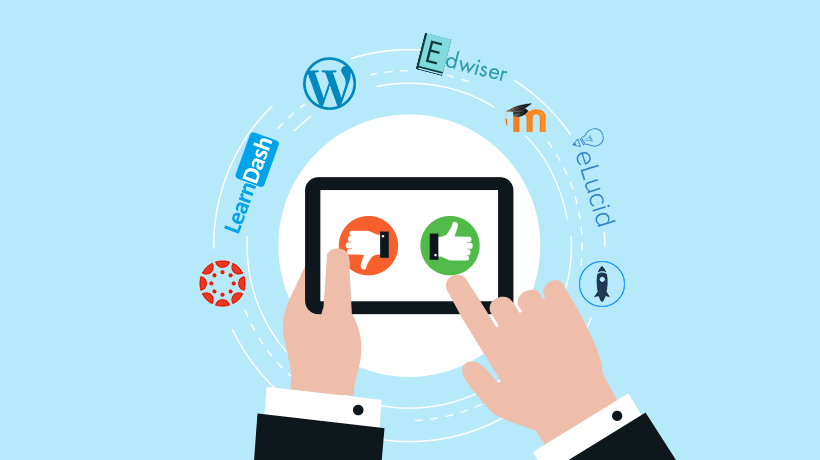7 Must-Have Features Of An Easy-To-Use LMS Platform
“Choose our LMS!”, they say. “It’s user-friendly!”, they say. But these are words you’ve heard before. In fact, almost every LMS vendor you’ve stumbled upon has promoted their platform as “easy to use”.
You’ve always wondered what this actually means. What makes their LMS platform easy to use? And is it easier to use than the next LMS on your list of Google search results? Plus, with over a thousand LMSs (and features) to choose from, how will you know if you’re making the right choice?
By knowing what to look for! Let’s dive into the must-have features and functionalities of every easy-to-use LMS, starting with logging in.
1. SSO That Is Easy To Log Into
In a digitally driven world, keeping track of login details across dozens of accounts can be, well, painful. Still, passwords are necessary protection to keep trolls and hackers at bay. So, lucky for us, technology has introduced a little trick called Single Sign-on (or SSO, for short).
Instead of having to remember yet another username and password, SSO allows you to use your credentials from one account to log into a different account. Neat, huh? You’ve probably even experienced SSO before, like when you get to use your Facebook credentials to log into a new app.
Now, in the same way, learners get quick, convenient and secure access to learning management software. A single sign-on LMS is a truly easy-to-use LMS platform.
2. Automations
If your LMS still requires courses to be manually assigned to every employee, supplier, and partner, then you can be sure that it’s not a top Learning Management System for usability. Because the more your LMS relies on manual processes, the bigger the administrative overhead.
So, what are you missing? Automations that make it easier for training administrators to streamline processes and achieve efficiencies that they wouldn’t be able to do on their own. In fact, with automations, one administrator can manage tasks across thousands of learners.
Whether it’s an integrated HR software that automatically enrolls new hires on your LMS, automated webinar sign-ups, or even the automatic assignment of courses to specific user groups, eLearning automations are the ultimate feature of any user-friendly LMS.
3. Makes Course Creation A Cinch
If yours is an easy-to-use LMS platform, creating and editing courses should be clear and simple. Of course, learning how to use any new platform takes time and practice—just some more than others.
With a user-friendly LMS, the learning curve should be relatively flat. In other words, by following a logical, easy-to-remember set of steps, anyone in your company is able to create online courses.
But knowing whether an LMS offers easy course creation can be tricky unless you hear it from existing or past customers. So, check out customer reviews of the LMS you’re considering, and look out for any warning signs that course creation is complex, time-consuming or best left to administrators and instructors.
4. Seamlessly Switchable
Oh, the roles you’ve played! Administrator, manager, instructor, and even learner. Switching between these roles, like when you need to view the LMS from a learner’s perspective, can be a user’s nightmare. Especially if your LMS requires you to log out and back in every time.
But, with an online Learning Management System, that’s easy to use, switching roles is effortless. Really, as little as two clicks! This saves time and energy and makes the User Experience all the better for it.
5. Fully Functional, And Barely Excessive
A study by Brandon Hall Group [1] found that 44% of companies using an LMS are thinking about replacing them. The top-ranking reasons? User Experience and administrative experience. But many LMSs today are packed with features that leave even the most experienced administrator on the edge of their chair. So, what’s gone wrong?
Well, there can be too much of a good thing. And sometimes, the shine of fancy features can leave you blind to your real needs. Instead of adding value, all of the LMS extras you thought you’d love actually just get in the way of smooth processes and learning objectives.
Now, it’s not to say that an LMS shouldn’t have impressive features. But they should be only the features that contribute toward a seamless and user-friendly LMS experience. After all, sending administrators on advanced courses to learn how to manage and run (wait for it) courses, is probably not how your company wants to spend its resources!
So, when you're researching a particular LMS, don’t get sidetracked by high-tech features, like VR and AI if you won’t actually use them. Stay focused on your specific list of training needs, and make sure that your LMS checks them all.
6. Branches Into Different User Segments
Branching has become key to the LMS User Experience. Segmenting your learner audience into categories means that you’re able to divide your training into different entities, each with its own set of courses, users, admins, and branding.
Then, within each branch, you can group learners according to specific criteria, like department or job level, and assign learners courses and themes based on their specific learning needs. Of course, this allows for mass assignment of courses, which saves time and energy. But it improves learners’ User Experience, too, because they get to follow a learning path that’s tailored to their needs.
7. Offers Maximum Support
Good LMS support answers the questions you asked, not the ones you didn’t. Because a quick and simple resolution to problems is a large part of the LMS User Experience. And getting stuck on error messages, with little help beyond generic FAQs and support emails, adds a frustrating delay to your workflow.
An LMS that’s easy to use comes with support that’s easy to find; and useful! The vendor’s support team should be clued up on all of the LMS’s features and functionalities, as well as customer training offered by the company.
Clear, simple self-help articles also go a long way toward saving users’ time. With a simple search, finding the LMS information you need means that you don’t need to spend time on the phone, or waiting for an email response. In short, the support you get from your vendor should leave you feeling like you’re in good hands.
Conclusion
Today, the right LMS won’t just save you time and resources. It’ll give employees the sort of online training experience that leads to real engagement and deep learning, too. On one condition: your LMS is easy to use.
Whether you’re evaluating your existing platform, or searching for a new vendor, using the criteria above will help you find an easy-to-use LMS platform, like TalentLMS, that offers a seamless User Experience.
References
[1] Research Summary: Learning Technology 2016 (http://go.brandonhall.com/l/8262/2016-04-25/5brswr)









